HRM Practices for Profitability and Productivity at Barclay's
VerifiedAdded on 2020/12/09
|18
|5123
|145
Report
AI Summary
This report delves into the multifaceted realm of Human Resource Management (HRM), outlining its core functions and purposes within an organizational context. It examines the vital processes of recruitment and selection, comparing the strengths and weaknesses of various methods. The report further explores the advantages of implementing different HRM practices for both employers and employees, emphasizing the significance of employee relations and employment legislation. Using Barclay's Bank as a case study, the report showcases the practical application of HRM principles to enhance profitability and productivity, offering valuable insights into strategic HRM. The report discusses the importance of employee welfare, training, and development, as well as the impact of leadership styles and organizational structure on HRM practices. Furthermore, it highlights the value of employee engagement through participative management, innovation, and flexible working options, demonstrating the holistic approach required for effective HRM.
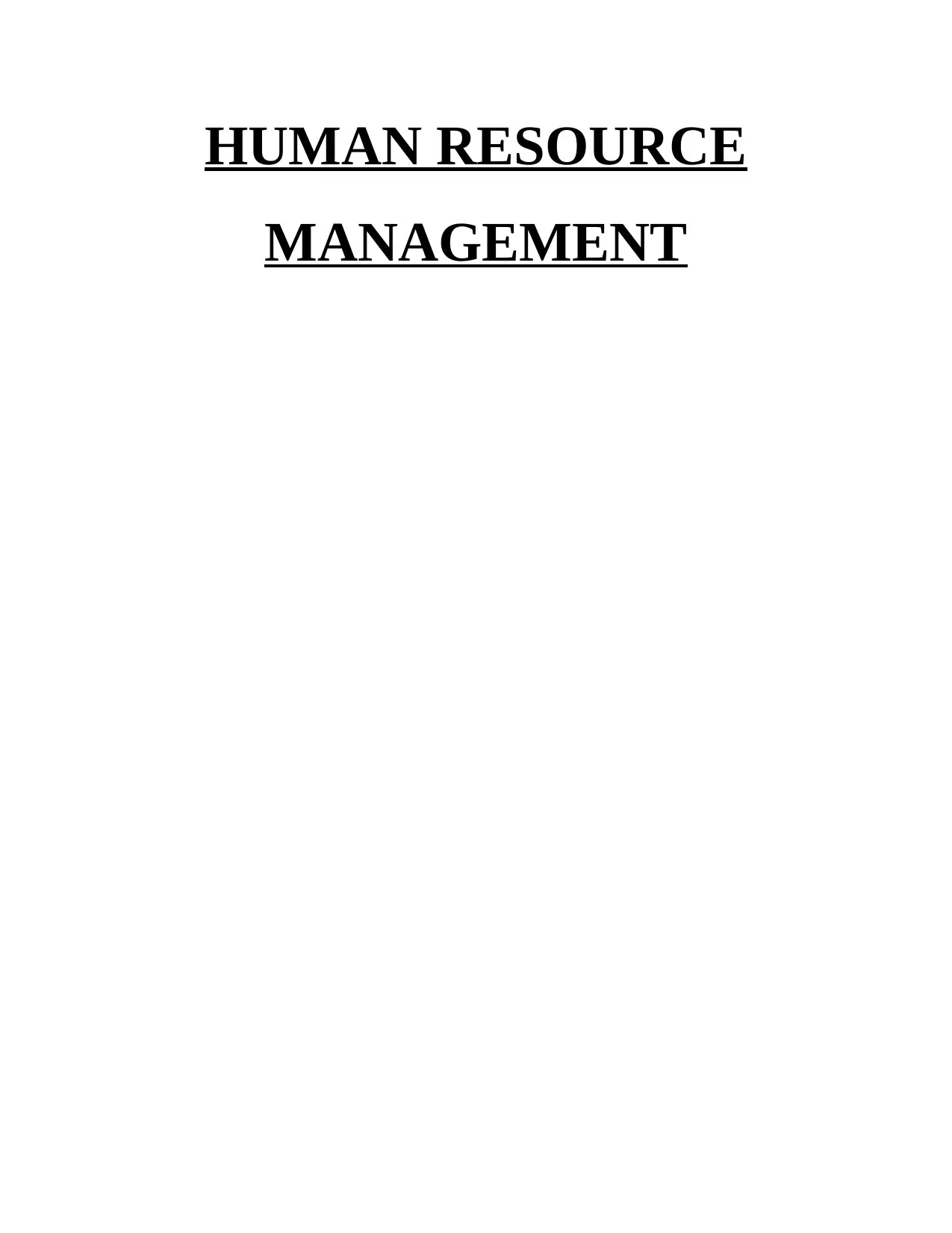
HUMAN RESOURCE
MANAGEMENT
MANAGEMENT
Paraphrase This Document
Need a fresh take? Get an instant paraphrase of this document with our AI Paraphraser
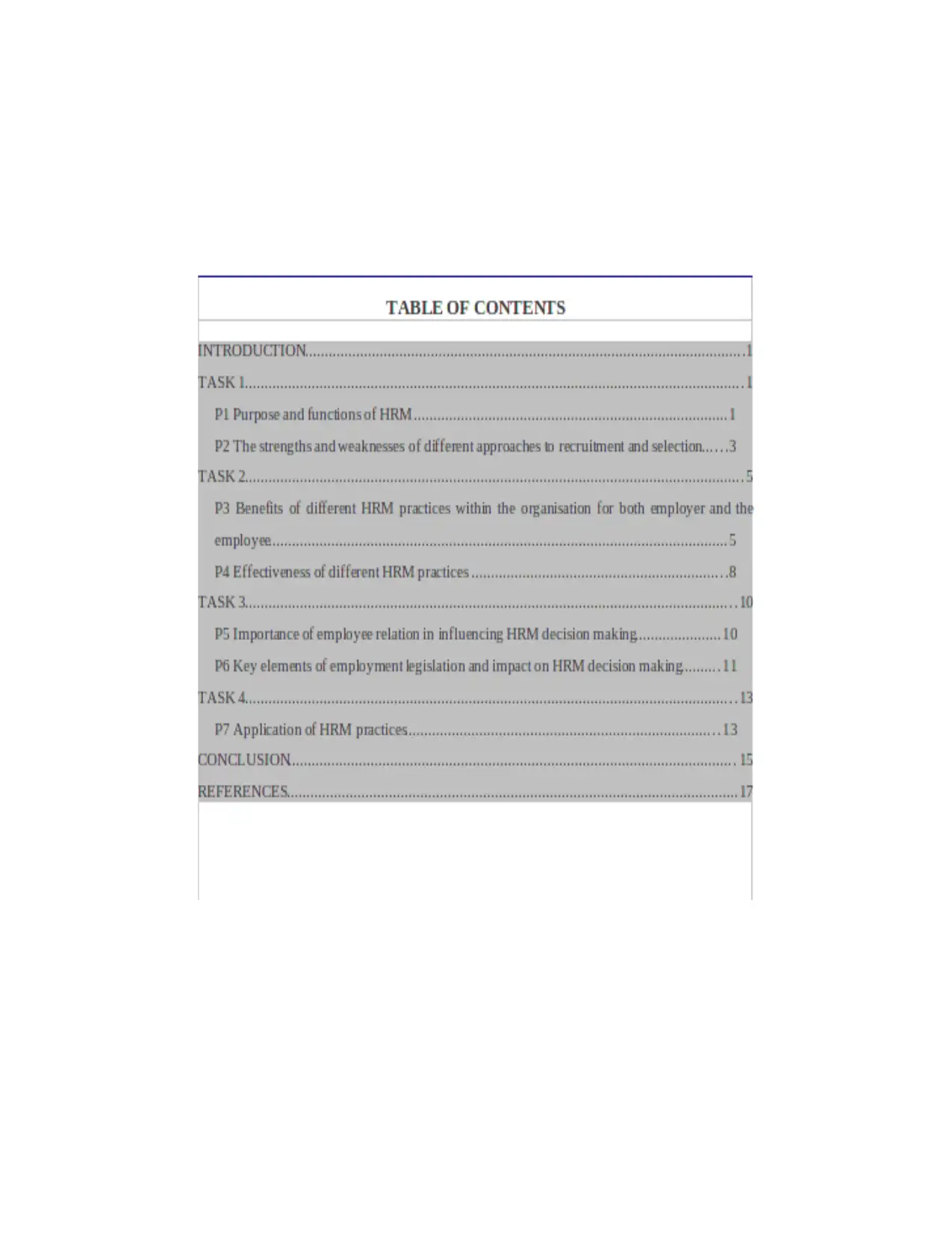
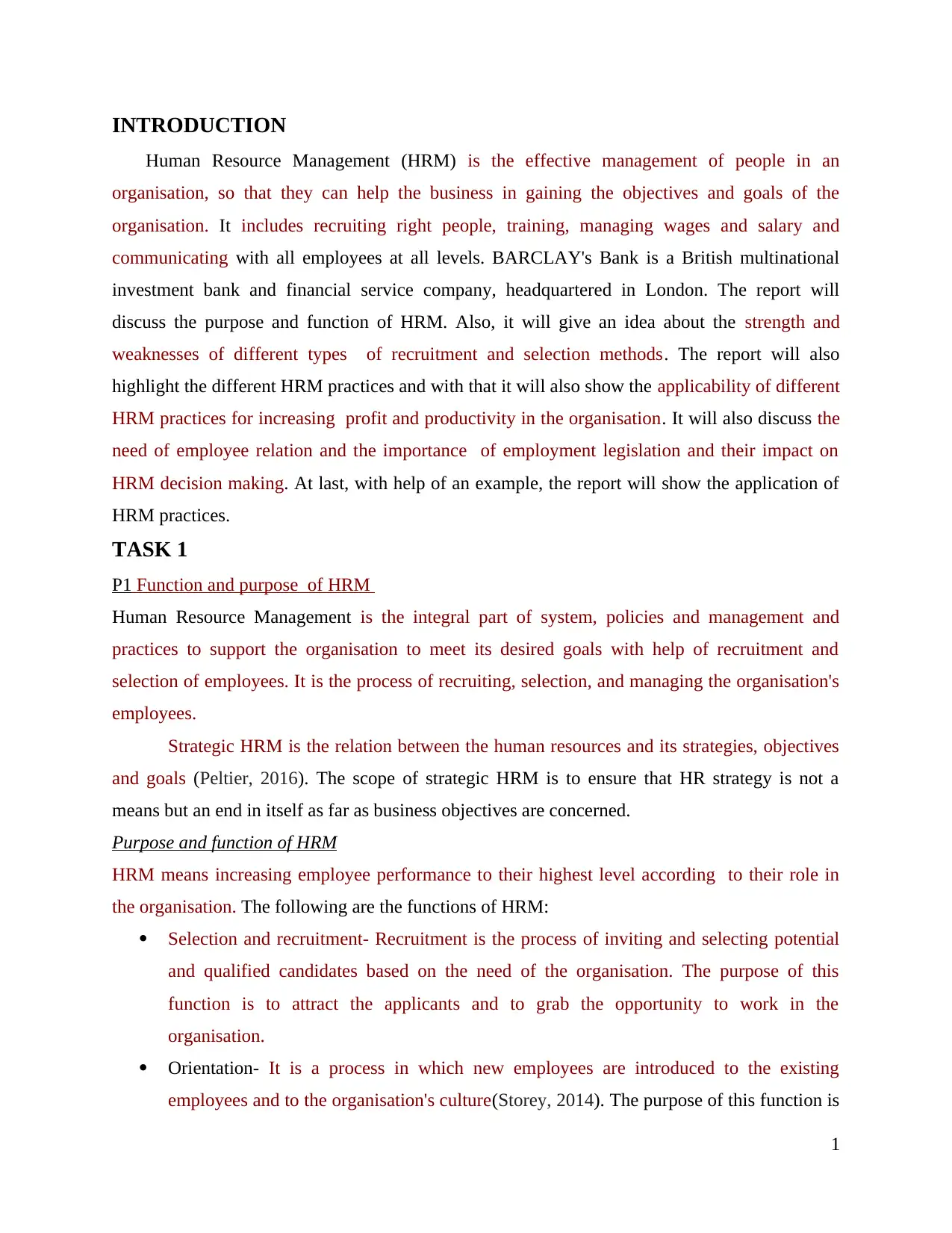
INTRODUCTION
Human Resource Management (HRM) is the effective management of people in an
organisation, so that they can help the business in gaining the objectives and goals of the
organisation. It includes recruiting right people, training, managing wages and salary and
communicating with all employees at all levels. BARCLAY's Bank is a British multinational
investment bank and financial service company, headquartered in London. The report will
discuss the purpose and function of HRM. Also, it will give an idea about the strength and
weaknesses of different types of recruitment and selection methods. The report will also
highlight the different HRM practices and with that it will also show the applicability of different
HRM practices for increasing profit and productivity in the organisation. It will also discuss the
need of employee relation and the importance of employment legislation and their impact on
HRM decision making. At last, with help of an example, the report will show the application of
HRM practices.
TASK 1
P1 Function and purpose of HRM
Human Resource Management is the integral part of system, policies and management and
practices to support the organisation to meet its desired goals with help of recruitment and
selection of employees. It is the process of recruiting, selection, and managing the organisation's
employees.
Strategic HRM is the relation between the human resources and its strategies, objectives
and goals (Peltier, 2016). The scope of strategic HRM is to ensure that HR strategy is not a
means but an end in itself as far as business objectives are concerned.
Purpose and function of HRM
HRM means increasing employee performance to their highest level according to their role in
the organisation. The following are the functions of HRM:
Selection and recruitment- Recruitment is the process of inviting and selecting potential
and qualified candidates based on the need of the organisation. The purpose of this
function is to attract the applicants and to grab the opportunity to work in the
organisation.
Orientation- It is a process in which new employees are introduced to the existing
employees and to the organisation's culture(Storey, 2014). The purpose of this function is
1
Human Resource Management (HRM) is the effective management of people in an
organisation, so that they can help the business in gaining the objectives and goals of the
organisation. It includes recruiting right people, training, managing wages and salary and
communicating with all employees at all levels. BARCLAY's Bank is a British multinational
investment bank and financial service company, headquartered in London. The report will
discuss the purpose and function of HRM. Also, it will give an idea about the strength and
weaknesses of different types of recruitment and selection methods. The report will also
highlight the different HRM practices and with that it will also show the applicability of different
HRM practices for increasing profit and productivity in the organisation. It will also discuss the
need of employee relation and the importance of employment legislation and their impact on
HRM decision making. At last, with help of an example, the report will show the application of
HRM practices.
TASK 1
P1 Function and purpose of HRM
Human Resource Management is the integral part of system, policies and management and
practices to support the organisation to meet its desired goals with help of recruitment and
selection of employees. It is the process of recruiting, selection, and managing the organisation's
employees.
Strategic HRM is the relation between the human resources and its strategies, objectives
and goals (Peltier, 2016). The scope of strategic HRM is to ensure that HR strategy is not a
means but an end in itself as far as business objectives are concerned.
Purpose and function of HRM
HRM means increasing employee performance to their highest level according to their role in
the organisation. The following are the functions of HRM:
Selection and recruitment- Recruitment is the process of inviting and selecting potential
and qualified candidates based on the need of the organisation. The purpose of this
function is to attract the applicants and to grab the opportunity to work in the
organisation.
Orientation- It is a process in which new employees are introduced to the existing
employees and to the organisation's culture(Storey, 2014). The purpose of this function is
1
⊘ This is a preview!⊘
Do you want full access?
Subscribe today to unlock all pages.

Trusted by 1+ million students worldwide
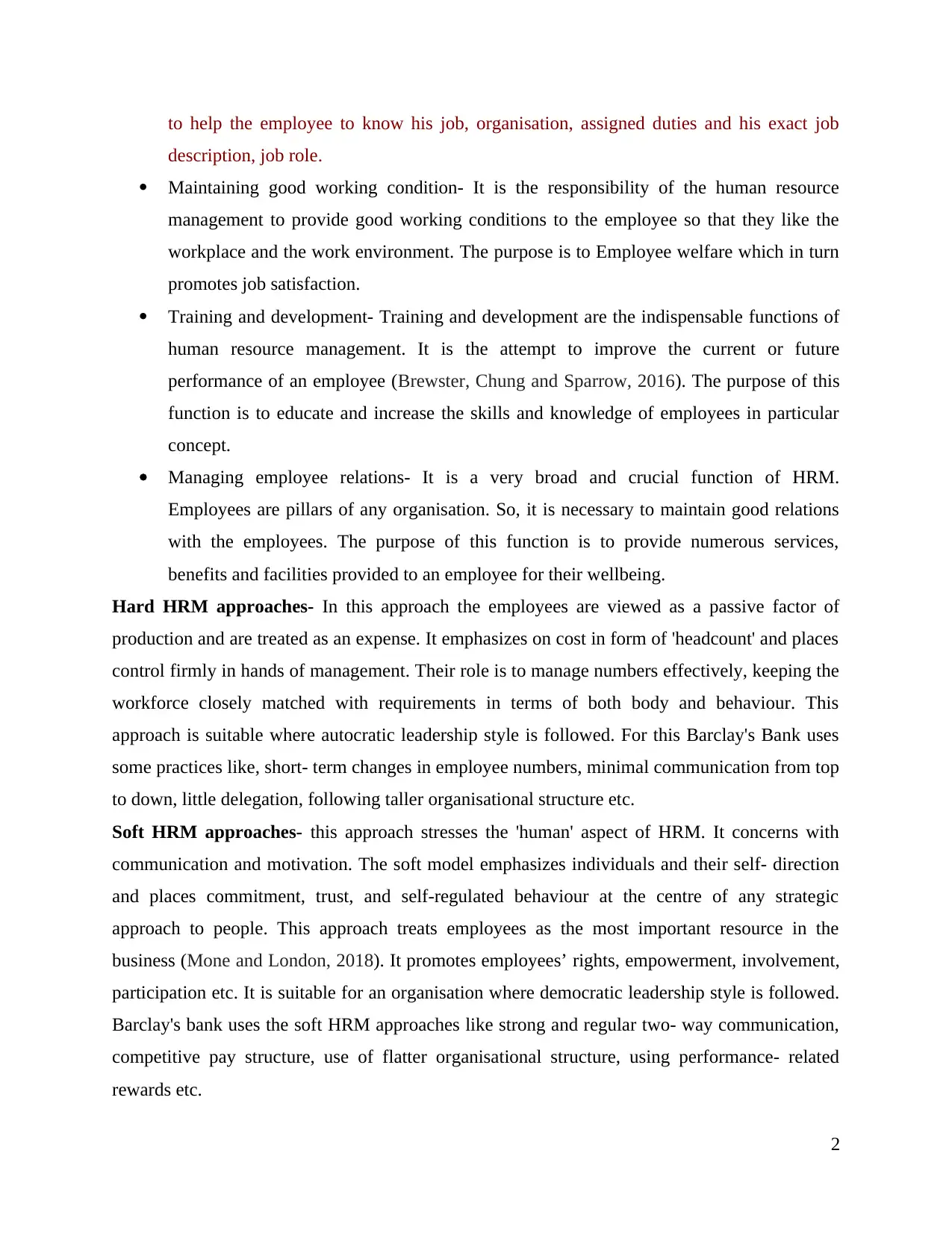
to help the employee to know his job, organisation, assigned duties and his exact job
description, job role.
Maintaining good working condition- It is the responsibility of the human resource
management to provide good working conditions to the employee so that they like the
workplace and the work environment. The purpose is to Employee welfare which in turn
promotes job satisfaction.
Training and development- Training and development are the indispensable functions of
human resource management. It is the attempt to improve the current or future
performance of an employee (Brewster, Chung and Sparrow, 2016). The purpose of this
function is to educate and increase the skills and knowledge of employees in particular
concept.
Managing employee relations- It is a very broad and crucial function of HRM.
Employees are pillars of any organisation. So, it is necessary to maintain good relations
with the employees. The purpose of this function is to provide numerous services,
benefits and facilities provided to an employee for their wellbeing.
Hard HRM approaches- In this approach the employees are viewed as a passive factor of
production and are treated as an expense. It emphasizes on cost in form of 'headcount' and places
control firmly in hands of management. Their role is to manage numbers effectively, keeping the
workforce closely matched with requirements in terms of both body and behaviour. This
approach is suitable where autocratic leadership style is followed. For this Barclay's Bank uses
some practices like, short- term changes in employee numbers, minimal communication from top
to down, little delegation, following taller organisational structure etc.
Soft HRM approaches- this approach stresses the 'human' aspect of HRM. It concerns with
communication and motivation. The soft model emphasizes individuals and their self- direction
and places commitment, trust, and self-regulated behaviour at the centre of any strategic
approach to people. This approach treats employees as the most important resource in the
business (Mone and London, 2018). It promotes employees’ rights, empowerment, involvement,
participation etc. It is suitable for an organisation where democratic leadership style is followed.
Barclay's bank uses the soft HRM approaches like strong and regular two- way communication,
competitive pay structure, use of flatter organisational structure, using performance- related
rewards etc.
2
description, job role.
Maintaining good working condition- It is the responsibility of the human resource
management to provide good working conditions to the employee so that they like the
workplace and the work environment. The purpose is to Employee welfare which in turn
promotes job satisfaction.
Training and development- Training and development are the indispensable functions of
human resource management. It is the attempt to improve the current or future
performance of an employee (Brewster, Chung and Sparrow, 2016). The purpose of this
function is to educate and increase the skills and knowledge of employees in particular
concept.
Managing employee relations- It is a very broad and crucial function of HRM.
Employees are pillars of any organisation. So, it is necessary to maintain good relations
with the employees. The purpose of this function is to provide numerous services,
benefits and facilities provided to an employee for their wellbeing.
Hard HRM approaches- In this approach the employees are viewed as a passive factor of
production and are treated as an expense. It emphasizes on cost in form of 'headcount' and places
control firmly in hands of management. Their role is to manage numbers effectively, keeping the
workforce closely matched with requirements in terms of both body and behaviour. This
approach is suitable where autocratic leadership style is followed. For this Barclay's Bank uses
some practices like, short- term changes in employee numbers, minimal communication from top
to down, little delegation, following taller organisational structure etc.
Soft HRM approaches- this approach stresses the 'human' aspect of HRM. It concerns with
communication and motivation. The soft model emphasizes individuals and their self- direction
and places commitment, trust, and self-regulated behaviour at the centre of any strategic
approach to people. This approach treats employees as the most important resource in the
business (Mone and London, 2018). It promotes employees’ rights, empowerment, involvement,
participation etc. It is suitable for an organisation where democratic leadership style is followed.
Barclay's bank uses the soft HRM approaches like strong and regular two- way communication,
competitive pay structure, use of flatter organisational structure, using performance- related
rewards etc.
2
Paraphrase This Document
Need a fresh take? Get an instant paraphrase of this document with our AI Paraphraser
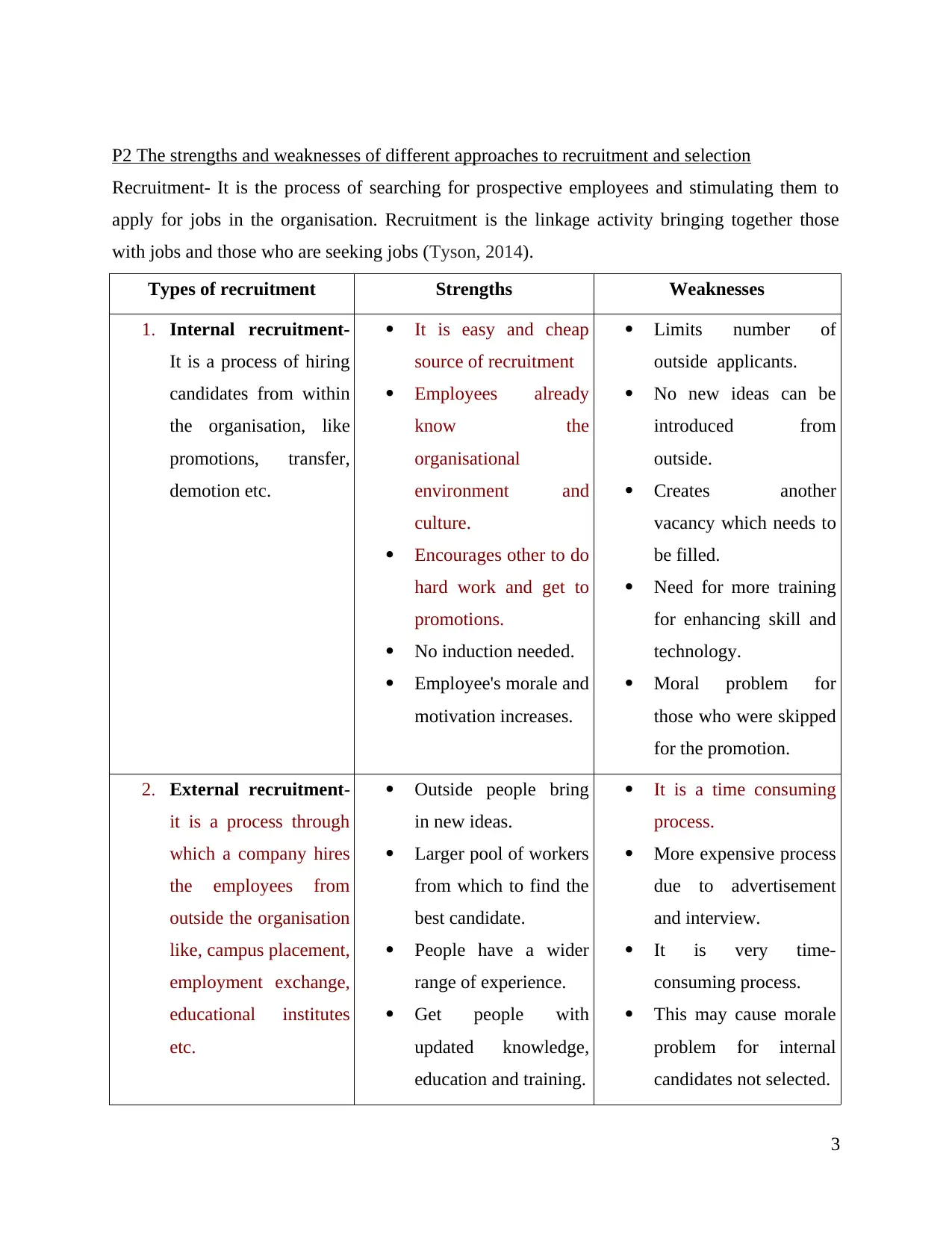
P2 The strengths and weaknesses of different approaches to recruitment and selection
Recruitment- It is the process of searching for prospective employees and stimulating them to
apply for jobs in the organisation. Recruitment is the linkage activity bringing together those
with jobs and those who are seeking jobs (Tyson, 2014).
Types of recruitment Strengths Weaknesses
1. Internal recruitment-
It is a process of hiring
candidates from within
the organisation, like
promotions, transfer,
demotion etc.
It is easy and cheap
source of recruitment
Employees already
know the
organisational
environment and
culture.
Encourages other to do
hard work and get to
promotions.
No induction needed.
Employee's morale and
motivation increases.
Limits number of
outside applicants.
No new ideas can be
introduced from
outside.
Creates another
vacancy which needs to
be filled.
Need for more training
for enhancing skill and
technology.
Moral problem for
those who were skipped
for the promotion.
2. External recruitment-
it is a process through
which a company hires
the employees from
outside the organisation
like, campus placement,
employment exchange,
educational institutes
etc.
Outside people bring
in new ideas.
Larger pool of workers
from which to find the
best candidate.
People have a wider
range of experience.
Get people with
updated knowledge,
education and training.
It is a time consuming
process.
More expensive process
due to advertisement
and interview.
It is very time-
consuming process.
This may cause morale
problem for internal
candidates not selected.
3
Recruitment- It is the process of searching for prospective employees and stimulating them to
apply for jobs in the organisation. Recruitment is the linkage activity bringing together those
with jobs and those who are seeking jobs (Tyson, 2014).
Types of recruitment Strengths Weaknesses
1. Internal recruitment-
It is a process of hiring
candidates from within
the organisation, like
promotions, transfer,
demotion etc.
It is easy and cheap
source of recruitment
Employees already
know the
organisational
environment and
culture.
Encourages other to do
hard work and get to
promotions.
No induction needed.
Employee's morale and
motivation increases.
Limits number of
outside applicants.
No new ideas can be
introduced from
outside.
Creates another
vacancy which needs to
be filled.
Need for more training
for enhancing skill and
technology.
Moral problem for
those who were skipped
for the promotion.
2. External recruitment-
it is a process through
which a company hires
the employees from
outside the organisation
like, campus placement,
employment exchange,
educational institutes
etc.
Outside people bring
in new ideas.
Larger pool of workers
from which to find the
best candidate.
People have a wider
range of experience.
Get people with
updated knowledge,
education and training.
It is a time consuming
process.
More expensive process
due to advertisement
and interview.
It is very time-
consuming process.
This may cause morale
problem for internal
candidates not selected.
3
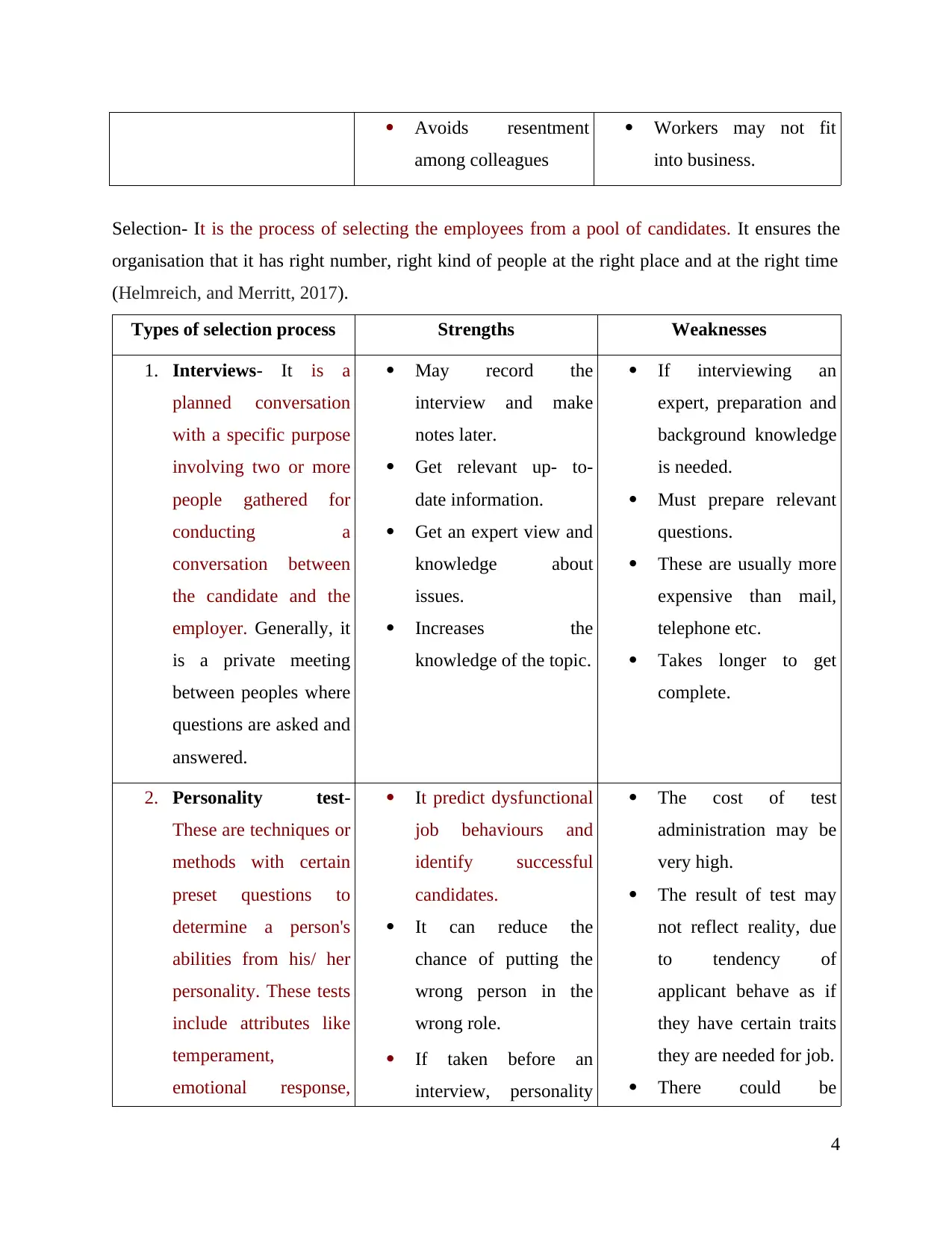
Avoids resentment
among colleagues
Workers may not fit
into business.
Selection- It is the process of selecting the employees from a pool of candidates. It ensures the
organisation that it has right number, right kind of people at the right place and at the right time
(Helmreich, and Merritt, 2017).
Types of selection process Strengths Weaknesses
1. Interviews- It is a
planned conversation
with a specific purpose
involving two or more
people gathered for
conducting a
conversation between
the candidate and the
employer. Generally, it
is a private meeting
between peoples where
questions are asked and
answered.
May record the
interview and make
notes later.
Get relevant up- to-
date information.
Get an expert view and
knowledge about
issues.
Increases the
knowledge of the topic.
If interviewing an
expert, preparation and
background knowledge
is needed.
Must prepare relevant
questions.
These are usually more
expensive than mail,
telephone etc.
Takes longer to get
complete.
2. Personality test-
These are techniques or
methods with certain
preset questions to
determine a person's
abilities from his/ her
personality. These tests
include attributes like
temperament,
emotional response,
It predict dysfunctional
job behaviours and
identify successful
candidates.
It can reduce the
chance of putting the
wrong person in the
wrong role.
If taken before an
interview, personality
The cost of test
administration may be
very high.
The result of test may
not reflect reality, due
to tendency of
applicant behave as if
they have certain traits
they are needed for job.
There could be
4
among colleagues
Workers may not fit
into business.
Selection- It is the process of selecting the employees from a pool of candidates. It ensures the
organisation that it has right number, right kind of people at the right place and at the right time
(Helmreich, and Merritt, 2017).
Types of selection process Strengths Weaknesses
1. Interviews- It is a
planned conversation
with a specific purpose
involving two or more
people gathered for
conducting a
conversation between
the candidate and the
employer. Generally, it
is a private meeting
between peoples where
questions are asked and
answered.
May record the
interview and make
notes later.
Get relevant up- to-
date information.
Get an expert view and
knowledge about
issues.
Increases the
knowledge of the topic.
If interviewing an
expert, preparation and
background knowledge
is needed.
Must prepare relevant
questions.
These are usually more
expensive than mail,
telephone etc.
Takes longer to get
complete.
2. Personality test-
These are techniques or
methods with certain
preset questions to
determine a person's
abilities from his/ her
personality. These tests
include attributes like
temperament,
emotional response,
It predict dysfunctional
job behaviours and
identify successful
candidates.
It can reduce the
chance of putting the
wrong person in the
wrong role.
If taken before an
interview, personality
The cost of test
administration may be
very high.
The result of test may
not reflect reality, due
to tendency of
applicant behave as if
they have certain traits
they are needed for job.
There could be
4
⊘ This is a preview!⊘
Do you want full access?
Subscribe today to unlock all pages.

Trusted by 1+ million students worldwide
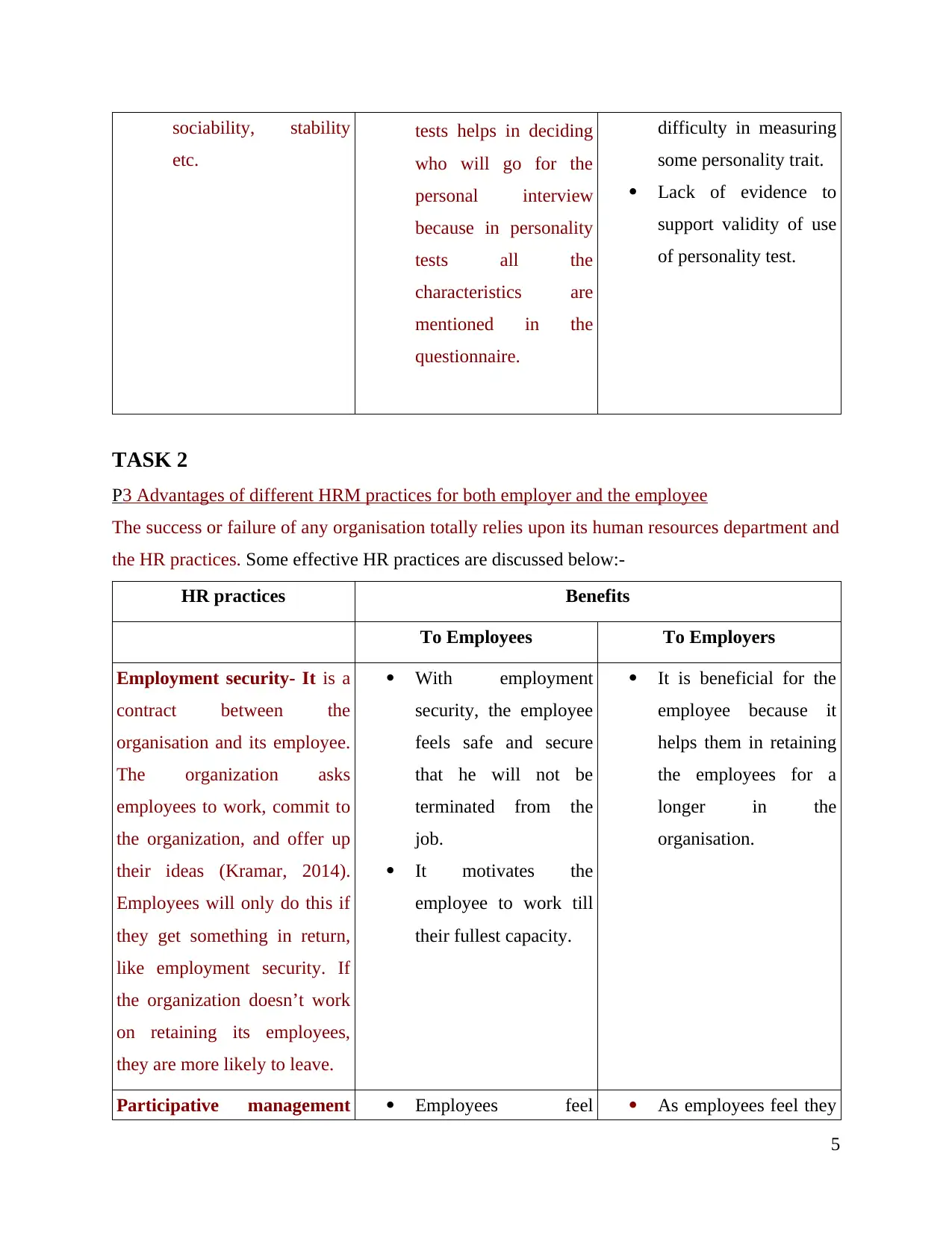
sociability, stability
etc.
tests helps in deciding
who will go for the
personal interview
because in personality
tests all the
characteristics are
mentioned in the
questionnaire.
difficulty in measuring
some personality trait.
Lack of evidence to
support validity of use
of personality test.
TASK 2
P3 Advantages of different HRM practices for both employer and the employee
The success or failure of any organisation totally relies upon its human resources department and
the HR practices. Some effective HR practices are discussed below:-
HR practices Benefits
To Employees To Employers
Employment security- It is a
contract between the
organisation and its employee.
The organization asks
employees to work, commit to
the organization, and offer up
their ideas (Kramar, 2014).
Employees will only do this if
they get something in return,
like employment security. If
the organization doesn’t work
on retaining its employees,
they are more likely to leave.
With employment
security, the employee
feels safe and secure
that he will not be
terminated from the
job.
It motivates the
employee to work till
their fullest capacity.
It is beneficial for the
employee because it
helps them in retaining
the employees for a
longer in the
organisation.
Participative management Employees feel As employees feel they
5
etc.
tests helps in deciding
who will go for the
personal interview
because in personality
tests all the
characteristics are
mentioned in the
questionnaire.
difficulty in measuring
some personality trait.
Lack of evidence to
support validity of use
of personality test.
TASK 2
P3 Advantages of different HRM practices for both employer and the employee
The success or failure of any organisation totally relies upon its human resources department and
the HR practices. Some effective HR practices are discussed below:-
HR practices Benefits
To Employees To Employers
Employment security- It is a
contract between the
organisation and its employee.
The organization asks
employees to work, commit to
the organization, and offer up
their ideas (Kramar, 2014).
Employees will only do this if
they get something in return,
like employment security. If
the organization doesn’t work
on retaining its employees,
they are more likely to leave.
With employment
security, the employee
feels safe and secure
that he will not be
terminated from the
job.
It motivates the
employee to work till
their fullest capacity.
It is beneficial for the
employee because it
helps them in retaining
the employees for a
longer in the
organisation.
Participative management Employees feel As employees feel they
5
Paraphrase This Document
Need a fresh take? Get an instant paraphrase of this document with our AI Paraphraser
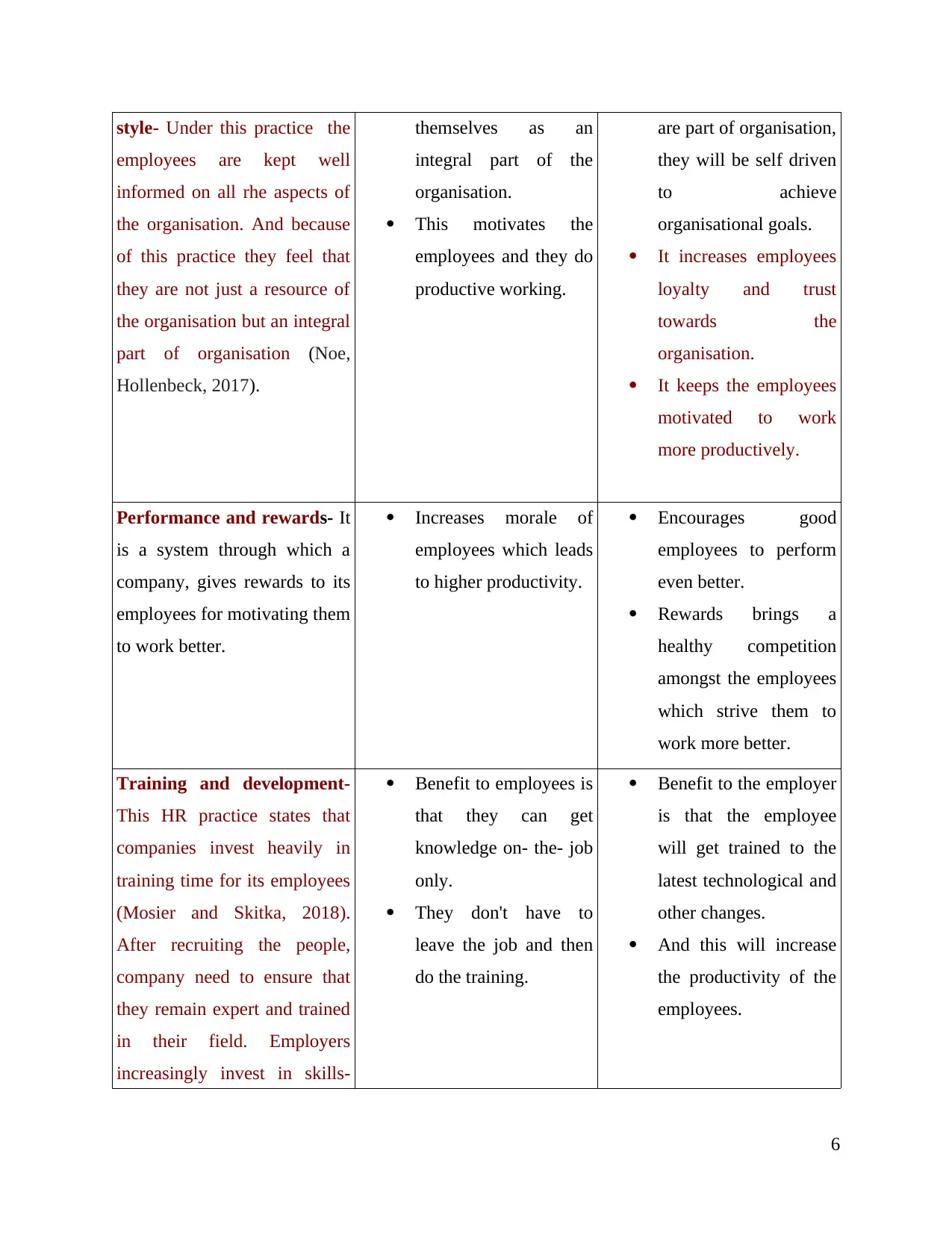
style- Under this practice the
employees are kept well
informed on all rhe aspects of
the organisation. And because
of this practice they feel that
they are not just a resource of
the organisation but an integral
part of organisation (Noe,
Hollenbeck, 2017).
themselves as an
integral part of the
organisation.
This motivates the
employees and they do
productive working.
are part of organisation,
they will be self driven
to achieve
organisational goals.
It increases employees
loyalty and trust
towards the
organisation.
It keeps the employees
motivated to work
more productively.
Performance and rewards- It
is a system through which a
company, gives rewards to its
employees for motivating them
to work better.
Increases morale of
employees which leads
to higher productivity.
Encourages good
employees to perform
even better.
Rewards brings a
healthy competition
amongst the employees
which strive them to
work more better.
Training and development-
This HR practice states that
companies invest heavily in
training time for its employees
(Mosier and Skitka, 2018).
After recruiting the people,
company need to ensure that
they remain expert and trained
in their field. Employers
increasingly invest in skills-
Benefit to employees is
that they can get
knowledge on- the- job
only.
They don't have to
leave the job and then
do the training.
Benefit to the employer
is that the employee
will get trained to the
latest technological and
other changes.
And this will increase
the productivity of the
employees.
6
employees are kept well
informed on all rhe aspects of
the organisation. And because
of this practice they feel that
they are not just a resource of
the organisation but an integral
part of organisation (Noe,
Hollenbeck, 2017).
themselves as an
integral part of the
organisation.
This motivates the
employees and they do
productive working.
are part of organisation,
they will be self driven
to achieve
organisational goals.
It increases employees
loyalty and trust
towards the
organisation.
It keeps the employees
motivated to work
more productively.
Performance and rewards- It
is a system through which a
company, gives rewards to its
employees for motivating them
to work better.
Increases morale of
employees which leads
to higher productivity.
Encourages good
employees to perform
even better.
Rewards brings a
healthy competition
amongst the employees
which strive them to
work more better.
Training and development-
This HR practice states that
companies invest heavily in
training time for its employees
(Mosier and Skitka, 2018).
After recruiting the people,
company need to ensure that
they remain expert and trained
in their field. Employers
increasingly invest in skills-
Benefit to employees is
that they can get
knowledge on- the- job
only.
They don't have to
leave the job and then
do the training.
Benefit to the employer
is that the employee
will get trained to the
latest technological and
other changes.
And this will increase
the productivity of the
employees.
6
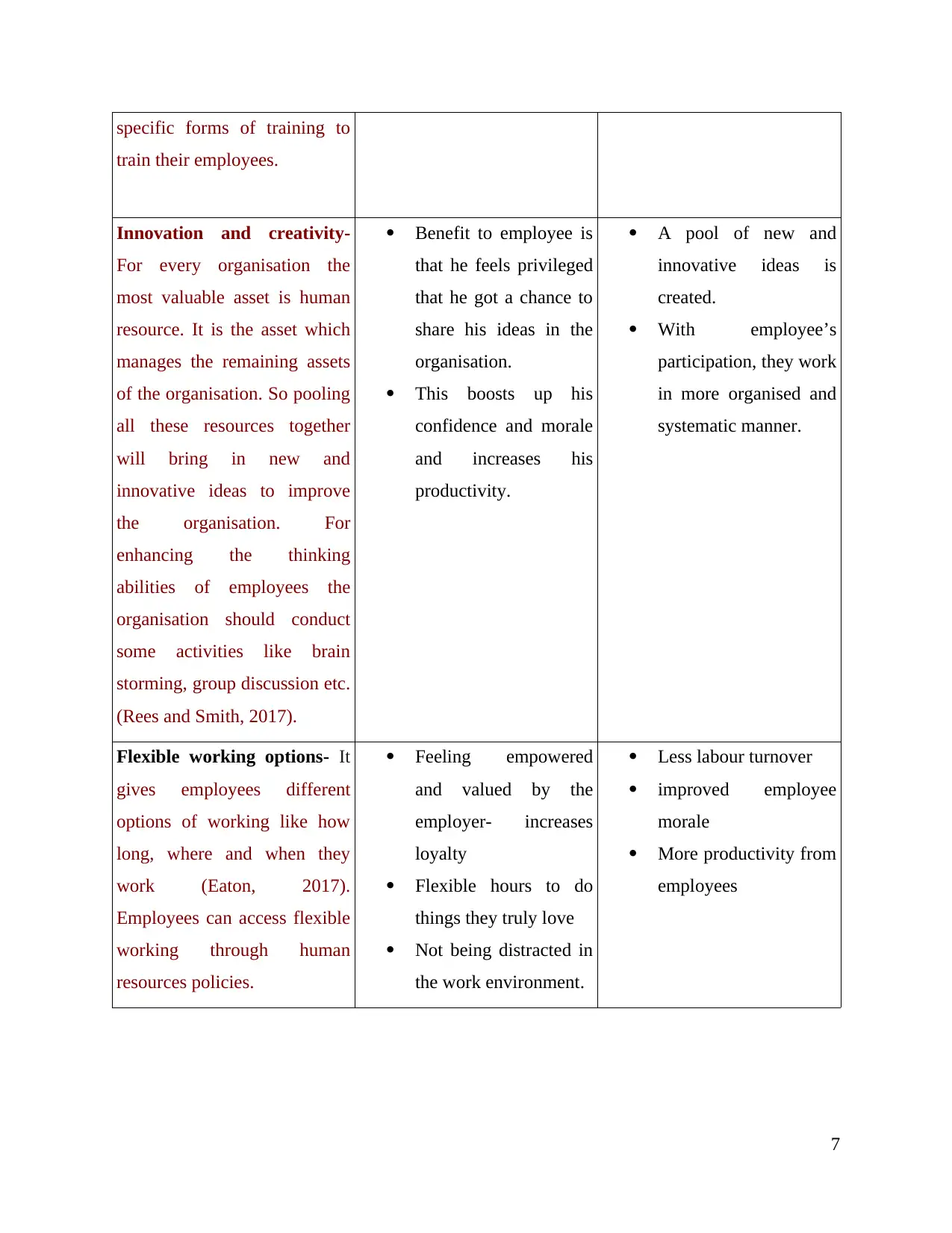
specific forms of training to
train their employees.
Innovation and creativity-
For every organisation the
most valuable asset is human
resource. It is the asset which
manages the remaining assets
of the organisation. So pooling
all these resources together
will bring in new and
innovative ideas to improve
the organisation. For
enhancing the thinking
abilities of employees the
organisation should conduct
some activities like brain
storming, group discussion etc.
(Rees and Smith, 2017).
Benefit to employee is
that he feels privileged
that he got a chance to
share his ideas in the
organisation.
This boosts up his
confidence and morale
and increases his
productivity.
A pool of new and
innovative ideas is
created.
With employee’s
participation, they work
in more organised and
systematic manner.
Flexible working options- It
gives employees different
options of working like how
long, where and when they
work (Eaton, 2017).
Employees can access flexible
working through human
resources policies.
Feeling empowered
and valued by the
employer- increases
loyalty
Flexible hours to do
things they truly love
Not being distracted in
the work environment.
Less labour turnover
improved employee
morale
More productivity from
employees
7
train their employees.
Innovation and creativity-
For every organisation the
most valuable asset is human
resource. It is the asset which
manages the remaining assets
of the organisation. So pooling
all these resources together
will bring in new and
innovative ideas to improve
the organisation. For
enhancing the thinking
abilities of employees the
organisation should conduct
some activities like brain
storming, group discussion etc.
(Rees and Smith, 2017).
Benefit to employee is
that he feels privileged
that he got a chance to
share his ideas in the
organisation.
This boosts up his
confidence and morale
and increases his
productivity.
A pool of new and
innovative ideas is
created.
With employee’s
participation, they work
in more organised and
systematic manner.
Flexible working options- It
gives employees different
options of working like how
long, where and when they
work (Eaton, 2017).
Employees can access flexible
working through human
resources policies.
Feeling empowered
and valued by the
employer- increases
loyalty
Flexible hours to do
things they truly love
Not being distracted in
the work environment.
Less labour turnover
improved employee
morale
More productivity from
employees
7
⊘ This is a preview!⊘
Do you want full access?
Subscribe today to unlock all pages.

Trusted by 1+ million students worldwide
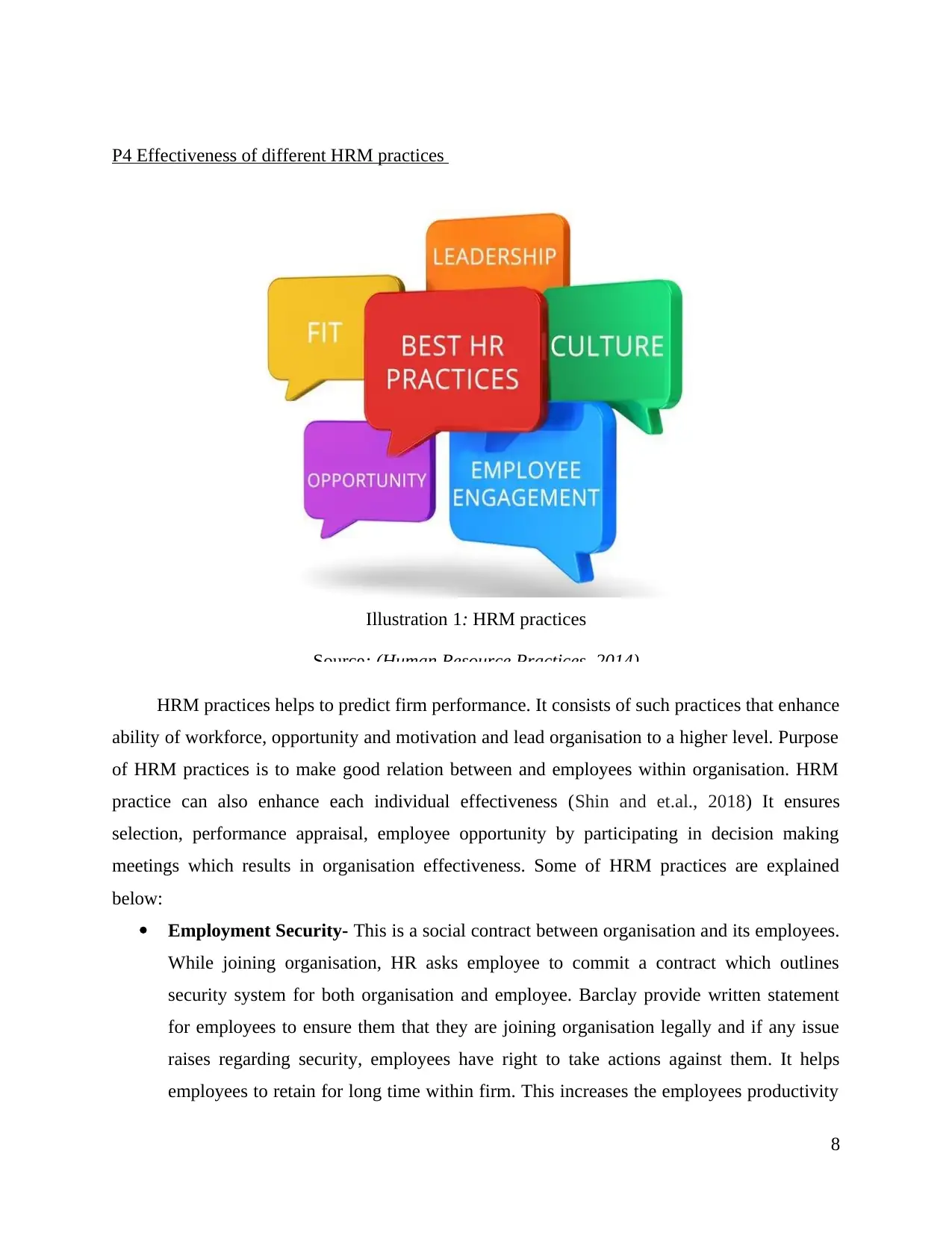
P4 Effectiveness of different HRM practices
HRM practices helps to predict firm performance. It consists of such practices that enhance
ability of workforce, opportunity and motivation and lead organisation to a higher level. Purpose
of HRM practices is to make good relation between and employees within organisation. HRM
practice can also enhance each individual effectiveness (Shin and et.al., 2018) It ensures
selection, performance appraisal, employee opportunity by participating in decision making
meetings which results in organisation effectiveness. Some of HRM practices are explained
below:
Employment Security- This is a social contract between organisation and its employees.
While joining organisation, HR asks employee to commit a contract which outlines
security system for both organisation and employee. Barclay provide written statement
for employees to ensure them that they are joining organisation legally and if any issue
raises regarding security, employees have right to take actions against them. It helps
employees to retain for long time within firm. This increases the employees productivity
8
Illustration 1: HRM practices
Source: (Human Resource Practices, 2014)
HRM practices helps to predict firm performance. It consists of such practices that enhance
ability of workforce, opportunity and motivation and lead organisation to a higher level. Purpose
of HRM practices is to make good relation between and employees within organisation. HRM
practice can also enhance each individual effectiveness (Shin and et.al., 2018) It ensures
selection, performance appraisal, employee opportunity by participating in decision making
meetings which results in organisation effectiveness. Some of HRM practices are explained
below:
Employment Security- This is a social contract between organisation and its employees.
While joining organisation, HR asks employee to commit a contract which outlines
security system for both organisation and employee. Barclay provide written statement
for employees to ensure them that they are joining organisation legally and if any issue
raises regarding security, employees have right to take actions against them. It helps
employees to retain for long time within firm. This increases the employees productivity
8
Illustration 1: HRM practices
Source: (Human Resource Practices, 2014)
Paraphrase This Document
Need a fresh take? Get an instant paraphrase of this document with our AI Paraphraser
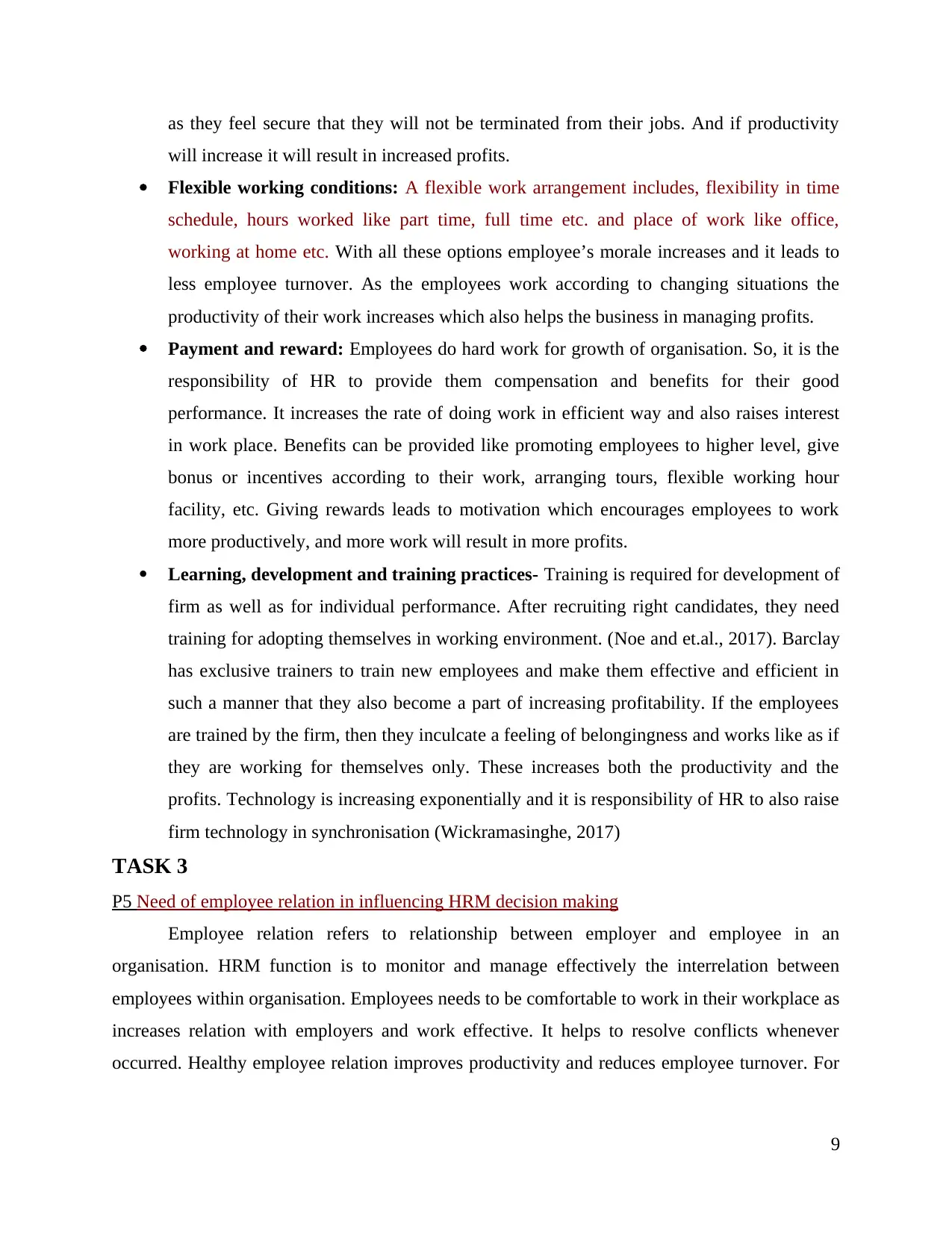
as they feel secure that they will not be terminated from their jobs. And if productivity
will increase it will result in increased profits.
Flexible working conditions: A flexible work arrangement includes, flexibility in time
schedule, hours worked like part time, full time etc. and place of work like office,
working at home etc. With all these options employee’s morale increases and it leads to
less employee turnover. As the employees work according to changing situations the
productivity of their work increases which also helps the business in managing profits.
Payment and reward: Employees do hard work for growth of organisation. So, it is the
responsibility of HR to provide them compensation and benefits for their good
performance. It increases the rate of doing work in efficient way and also raises interest
in work place. Benefits can be provided like promoting employees to higher level, give
bonus or incentives according to their work, arranging tours, flexible working hour
facility, etc. Giving rewards leads to motivation which encourages employees to work
more productively, and more work will result in more profits.
Learning, development and training practices- Training is required for development of
firm as well as for individual performance. After recruiting right candidates, they need
training for adopting themselves in working environment. (Noe and et.al., 2017). Barclay
has exclusive trainers to train new employees and make them effective and efficient in
such a manner that they also become a part of increasing profitability. If the employees
are trained by the firm, then they inculcate a feeling of belongingness and works like as if
they are working for themselves only. These increases both the productivity and the
profits. Technology is increasing exponentially and it is responsibility of HR to also raise
firm technology in synchronisation (Wickramasinghe, 2017)
TASK 3
P5 Need of employee relation in influencing HRM decision making
Employee relation refers to relationship between employer and employee in an
organisation. HRM function is to monitor and manage effectively the interrelation between
employees within organisation. Employees needs to be comfortable to work in their workplace as
increases relation with employers and work effective. It helps to resolve conflicts whenever
occurred. Healthy employee relation improves productivity and reduces employee turnover. For
9
will increase it will result in increased profits.
Flexible working conditions: A flexible work arrangement includes, flexibility in time
schedule, hours worked like part time, full time etc. and place of work like office,
working at home etc. With all these options employee’s morale increases and it leads to
less employee turnover. As the employees work according to changing situations the
productivity of their work increases which also helps the business in managing profits.
Payment and reward: Employees do hard work for growth of organisation. So, it is the
responsibility of HR to provide them compensation and benefits for their good
performance. It increases the rate of doing work in efficient way and also raises interest
in work place. Benefits can be provided like promoting employees to higher level, give
bonus or incentives according to their work, arranging tours, flexible working hour
facility, etc. Giving rewards leads to motivation which encourages employees to work
more productively, and more work will result in more profits.
Learning, development and training practices- Training is required for development of
firm as well as for individual performance. After recruiting right candidates, they need
training for adopting themselves in working environment. (Noe and et.al., 2017). Barclay
has exclusive trainers to train new employees and make them effective and efficient in
such a manner that they also become a part of increasing profitability. If the employees
are trained by the firm, then they inculcate a feeling of belongingness and works like as if
they are working for themselves only. These increases both the productivity and the
profits. Technology is increasing exponentially and it is responsibility of HR to also raise
firm technology in synchronisation (Wickramasinghe, 2017)
TASK 3
P5 Need of employee relation in influencing HRM decision making
Employee relation refers to relationship between employer and employee in an
organisation. HRM function is to monitor and manage effectively the interrelation between
employees within organisation. Employees needs to be comfortable to work in their workplace as
increases relation with employers and work effective. It helps to resolve conflicts whenever
occurred. Healthy employee relation improves productivity and reduces employee turnover. For
9
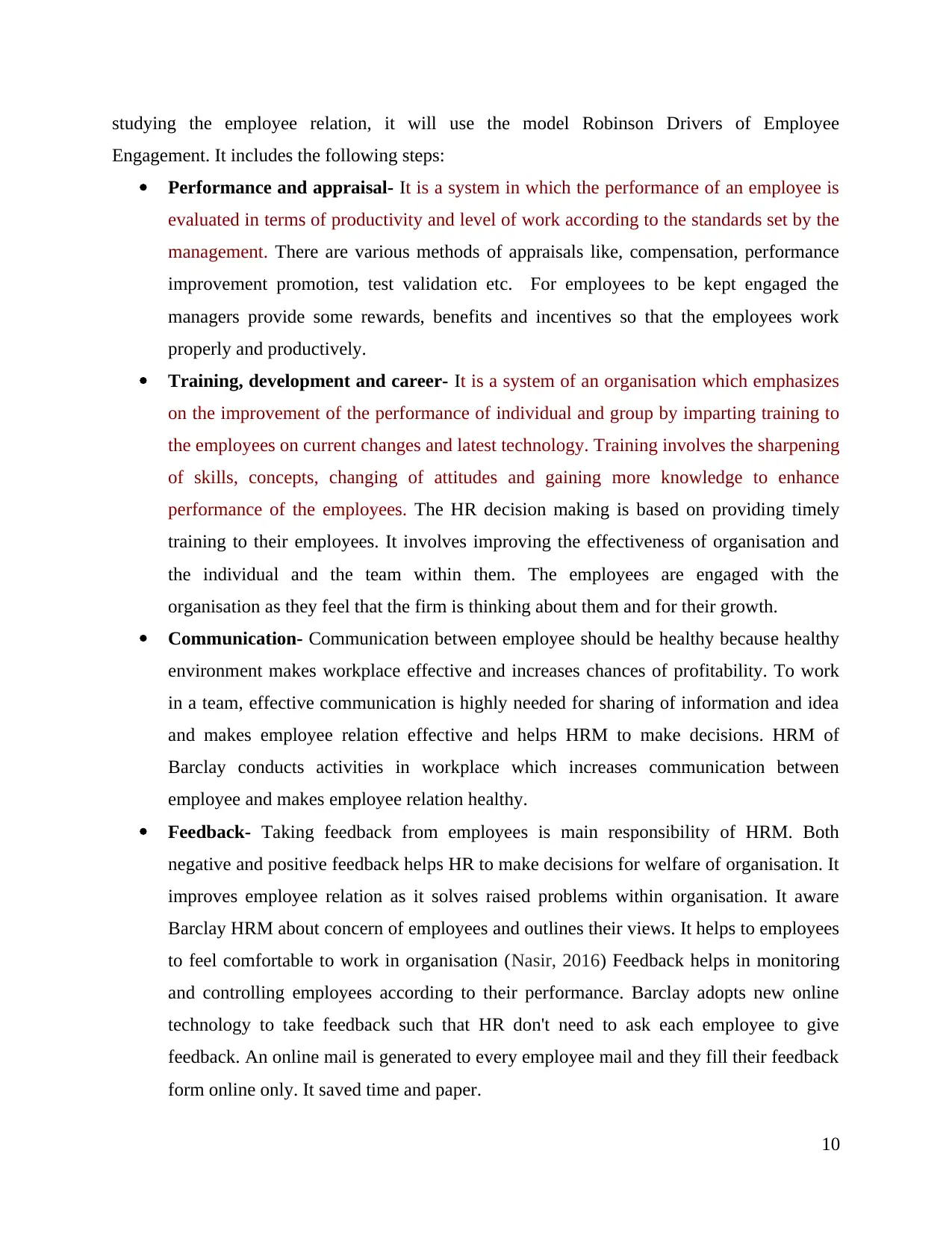
studying the employee relation, it will use the model Robinson Drivers of Employee
Engagement. It includes the following steps:
Performance and appraisal- It is a system in which the performance of an employee is
evaluated in terms of productivity and level of work according to the standards set by the
management. There are various methods of appraisals like, compensation, performance
improvement promotion, test validation etc. For employees to be kept engaged the
managers provide some rewards, benefits and incentives so that the employees work
properly and productively.
Training, development and career- It is a system of an organisation which emphasizes
on the improvement of the performance of individual and group by imparting training to
the employees on current changes and latest technology. Training involves the sharpening
of skills, concepts, changing of attitudes and gaining more knowledge to enhance
performance of the employees. The HR decision making is based on providing timely
training to their employees. It involves improving the effectiveness of organisation and
the individual and the team within them. The employees are engaged with the
organisation as they feel that the firm is thinking about them and for their growth.
Communication- Communication between employee should be healthy because healthy
environment makes workplace effective and increases chances of profitability. To work
in a team, effective communication is highly needed for sharing of information and idea
and makes employee relation effective and helps HRM to make decisions. HRM of
Barclay conducts activities in workplace which increases communication between
employee and makes employee relation healthy.
Feedback- Taking feedback from employees is main responsibility of HRM. Both
negative and positive feedback helps HR to make decisions for welfare of organisation. It
improves employee relation as it solves raised problems within organisation. It aware
Barclay HRM about concern of employees and outlines their views. It helps to employees
to feel comfortable to work in organisation (Nasir, 2016) Feedback helps in monitoring
and controlling employees according to their performance. Barclay adopts new online
technology to take feedback such that HR don't need to ask each employee to give
feedback. An online mail is generated to every employee mail and they fill their feedback
form online only. It saved time and paper.
10
Engagement. It includes the following steps:
Performance and appraisal- It is a system in which the performance of an employee is
evaluated in terms of productivity and level of work according to the standards set by the
management. There are various methods of appraisals like, compensation, performance
improvement promotion, test validation etc. For employees to be kept engaged the
managers provide some rewards, benefits and incentives so that the employees work
properly and productively.
Training, development and career- It is a system of an organisation which emphasizes
on the improvement of the performance of individual and group by imparting training to
the employees on current changes and latest technology. Training involves the sharpening
of skills, concepts, changing of attitudes and gaining more knowledge to enhance
performance of the employees. The HR decision making is based on providing timely
training to their employees. It involves improving the effectiveness of organisation and
the individual and the team within them. The employees are engaged with the
organisation as they feel that the firm is thinking about them and for their growth.
Communication- Communication between employee should be healthy because healthy
environment makes workplace effective and increases chances of profitability. To work
in a team, effective communication is highly needed for sharing of information and idea
and makes employee relation effective and helps HRM to make decisions. HRM of
Barclay conducts activities in workplace which increases communication between
employee and makes employee relation healthy.
Feedback- Taking feedback from employees is main responsibility of HRM. Both
negative and positive feedback helps HR to make decisions for welfare of organisation. It
improves employee relation as it solves raised problems within organisation. It aware
Barclay HRM about concern of employees and outlines their views. It helps to employees
to feel comfortable to work in organisation (Nasir, 2016) Feedback helps in monitoring
and controlling employees according to their performance. Barclay adopts new online
technology to take feedback such that HR don't need to ask each employee to give
feedback. An online mail is generated to every employee mail and they fill their feedback
form online only. It saved time and paper.
10
⊘ This is a preview!⊘
Do you want full access?
Subscribe today to unlock all pages.

Trusted by 1+ million students worldwide
1 out of 18
Related Documents
Your All-in-One AI-Powered Toolkit for Academic Success.
+13062052269
info@desklib.com
Available 24*7 on WhatsApp / Email
![[object Object]](/_next/static/media/star-bottom.7253800d.svg)
Unlock your academic potential
Copyright © 2020–2025 A2Z Services. All Rights Reserved. Developed and managed by ZUCOL.





